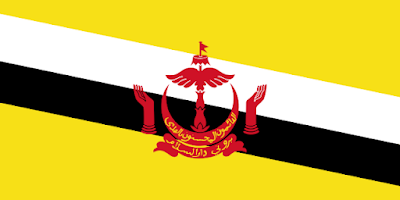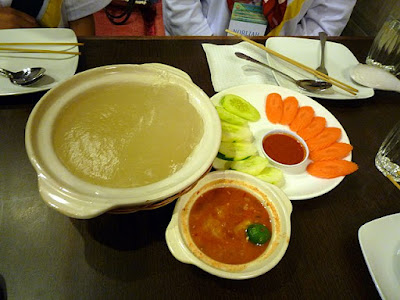Flag of Brunei: a symbol of unity, tradition and sovereignty
Flags are powerful symbols that represent the identity, history and aspirations of a nation. The flag of Brunei, with its distinctive design and rich symbolism, is a symbol of the country's unity, tradition and sovereignty. In this article, we will explore the features and meaning behind the flag of Brunei, highlighting its importance to the country and its people.
Design & Color:
The flag of Brunei consists of a rectangular field of yellow, with two diagonal stripes of white and black at the upper fly corner. The width of the bands is proportional to the width of the flag, and they slope down towards the hoist corner. The yellow field represents the Sultanate of Brunei, while the white and black diagonal bands symbolize the country's chief ministers.
Symbolism:
The design elements of the Brunei flag have historical, cultural and political significance. The yellow colour, known as "kuning emas" in Malay, represents royalty and sovereignty. It pays homage to the Brunei Sultanate, one of the oldest continuously ruling monarchies in the world. The yellow field symbolizes the supreme authority of the Sultan and the unity of the Bruneian people under his leadership.
The white and black diagonal bands hold significant cultural and religious meaning. The white stripe represents purity, while the black stripe symbolizes Brunei's independence. Collectively, the colors express Brunei's commitment to justice, integrity and the preservation of its cultural heritage.
historical context:
The current design of the Brunei flag was officially adopted on September 29, 1959, following the country's independence from the British Empire. However, the origin of the flag can be traced back to the 14th century, when the Kingdom of Brunei was at its height. Historical records show that yellow was the predominant color in the Brunei flag of that era, signifying the kingdom's royal lineage and prestigious status.
The introduction of the white and black diagonal bands is attributed to Sultan Omar Ali Saifuddin III, who implemented the design during his reign in 1906. The inclusion of these bands marked an important milestone in Brunei's history, symbolizing the unity between the sultanate and the chiefdoms.
The Brunei flag serves as a unifying symbol that represents the country's values and aspirations. It instills a sense of national pride and loyalty among the Bruneian people, fostering a strong collective identity. The flag is displayed prominently on public buildings, educational institutions and during national events, thereby instilling a sense of patriotism and unity.
Furthermore, the flag plays an important role in international diplomacy, representing Brunei in various forums and events around the world. It serves as a visual representation of the country's sovereignty and provides a unique identity that differentiates Brunei from other countries.
The flag of Brunei is a powerful symbol that reflects the unity, tradition and sovereignty of the country. Its design elements and colors hold deep cultural, historical and political significance, representing the values and aspirations of the Bruneian people. As Brunei continues to deal with the challenges of the modern world, its flag will continue to be a symbol of pride and resilience, reminding its citizens of their rich heritage and their shared commitment to progress and unity.
Brunei, located on the island of Borneo, boasts a rich culinary heritage influenced by Malay, Chinese and Indian cuisines. Bruneian cuisine offers a delightful mix of flavours, spices and cooking techniques. Here are some notable foods from Brunei:
foods of Brunei
- Ambuyat: Considered the national dish of Brunei, ambuyat is made from the starchy stem of the sago tree. It has a glue-like consistency and is usually eaten with a bamboo fork called "chandas". Ambuyat is often accompanied by various condiments such as sambal (spicy sauce), fried fish and vegetables.
- Nasi Katok: A popular and affordable street food, nasi katok consists of a piece of fried chicken piled over white rice and served with a spicy chili sauce. It is a simple yet delicious dish that can be found at many local eateries throughout Brunei.
- Ayam Penyat: This Indonesian-inspired dish has made its way to Brunei and gained popularity. Ayam penayet features a deep-fried chicken battered to form a crispy exterior, served with aromatic rice, fried tofu, tempeh and a spicy sambal sauce.
- Ambuyat Gulai: A variation of the traditional Ambuyat Gulai, Ambuyat Gulai includes a savory curry sauce made from spices, coconut milk and various herbs. The thick and creamy gulai enhances the flavor and texture of ambuyat, making it a delicious and satisfying dish.
- Kelupis: Kelupis is a traditional snack made from sticky rice wrapped in a banana leaf. The rice is filled with ingredients such as grated coconut and sometimes a piece of prawn or meat. Kelupis is steamed, giving it a sticky texture and an aroma of banana leaves.
- Soto Brunei: Soto is a popular soup dish in Brunei, often eaten for breakfast or lunch. It consists of a savory broth made from chicken or beef, flavored with aromatic herbs and spices. The soup is served with vermicelli noodles, shredded chicken or beef, bean sprouts and a variety of condiments such as lemon, fried onions and sambal.
- Ambeng: Ambeng is a traditional community dish usually served on festive occasions. It includes an eclectic spread of different dishes including rice, chicken, beef, vegetables, sambal and other side dishes. Ambang represents the spirit of sharing and togetherness in the culture of Brunei.
- Kuih Melaya: Brunei's dessert scene serves up a wide range of sweet treats, and kuih melaya is a popular choice. These colorful and bite-sized cakes are made from glutinous rice flour and coconut milk, resulting in a soft and slightly chewy texture. Kuih melaya comes in a variety of sizes and flavours, often with a delightful pandan or coconut aroma.


Comments
Post a Comment